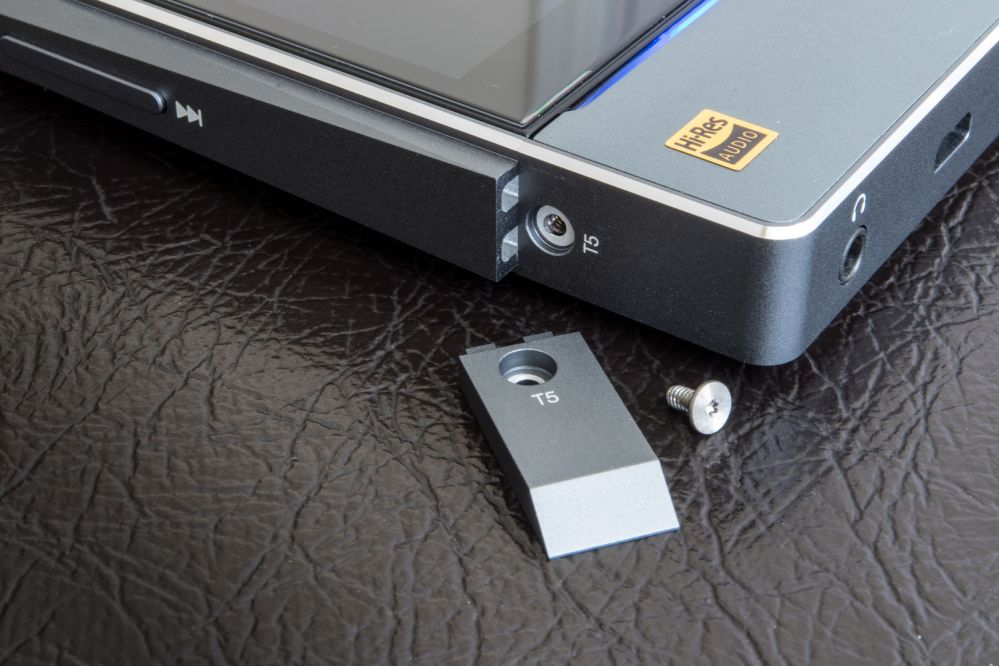Design –

As mentioned in Fiio’s promotional material, the X7 II is a comfortable fusion between the X5 III and the original X7, sporting a very similar design to its predecessor with that angled ridging on the left-hand side. But that’s not to say that Fiio simply stuck that control bar onto the side of the original X7 and called it a day, while they may not be radically different, the X7 II has been considerably reformed and refined. And like these models, the X7 II has impeccable build quality with a full aluminium build, lustrous chamfered edges and super tight tolerances to every angle. The X7 II also maintains the modularity of the X7 with swappable amplifier modules and due to some smart engineering on Fiio’s behalf, the X7 II also retains compatibility with the original amp modules designed for the X7.

The X7 II is a handsome device and very much an improvement over the X7 is almost every way. Starting with dimensions, the X7 II has been slimmed down by a millimetre so the screen lies flush with the front of the device, it’s subtle but makes the entire device look that much cleaner. The X7 II is slightly shorter but is a tad thicker on behalf of that angled side bar. Fiio has also updated the finish of the device, their new flagship sports a finer sand blasted finish that feels softer and more tactile in the hand. While the X7 II retains the plastic antenna window of the original, the back of the device is appreciably more uniform. And in culmination, these styling tweaks make the X7 II look considerably thinner and sleeker than the X7 even though their dimensions are mostly similar.

When it comes to machining and materials, the X7 II tells much the same story as before. Despite being slightly smaller, it is not a light or particularly compact device but one that has incredible rigidity and durability. From perfectly machined chamfers to that strikingly angular control bar on the left side, the X7 II is both bold and handsome. Furthermore, the device’s taller, smartphone-like dimensions conformed excellently to my smaller hands. But perhaps the biggest difference between the X7 II and the original X7 is its updated control scheme. The X7 II forgoes the symmetrical controls of the original in favour of a more separated layout that avoided any accidental presses in my testing, much improved over the X5 III and its more delineated controls are easier to operate than the X7 when in a pocket.

The right side is now completely dedicated to two micro sd card slots with integrated trays like the X5 III, an improvement over the single exposed slot of the original.

Meanwhile, the left side now houses a volume wheel instead of the rocker of the original with a track skip rocker just below and play/pause button just above. The wheel is similar to the X5 III, very nicely knurled and thoroughly premium, but it is still a bit insensitive for larger volume adjustments when in my pocket (though Fiio have a digital slider on the screen to speed this up).

The power button has also been relocated to the top right corner, it is larger and more distinct, no longer suffering from accidental presses in my pocket. I also noticed that the buttons are far clickier than before with greater travel, they feel far more tactile than those on the X5 III and original X7. The outputs have also been updated, at the top, the X7 II retains the line out/coax output of the original, however, at the bottom, users will notice that the X7 II now comes with a balanced output from factory in addition to a regular 3.5mm jack.

The X7 II also retains exactly the same modular interface as the X7 which maintains compatibility with the AM1-5 modules. Of note, the added ridge on the side is just a metal plate that slots into the main housing and screws onto the side of the module.

The X7 II does stick with a traditional micro-usb connector to maintain compatibility with DK1 and K5 though reversible micro-usb cables can be easily found online should you want that functionality.
Next Page: Usage




4 Responses
Sorry Eric, haven’t heard the Opus players, I will try my best to look into their products in future.
Hard to say, I found the unbalanced AM3A output to drive my M&D MH40’s and higher impedance in-ears just fine. It did struggle a bit with my 150ohm HD700’s but it should be fine for the AKG’s.
Nice Ryan. Was just wondering if you could give a quick comparison between this Fiio X7 II vs the Opus 1 plastic edition? Which would you say is better and more detailed/resolving?
Thanks
Thanks for superb reviews. Only one aditional question :
With the new AM3A amplifier module, is this x7 ll capable of delivering satisfactory power to power unbalanced 62 Ohms headphones like the AKG 712 PRO?